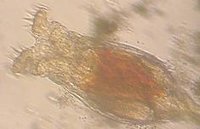Rotifer
|
|
| Rotifers | ||||
|---|---|---|---|---|
 Philodina, feeding | ||||
| Scientific classification | ||||
| ||||
| Classes | ||||
The rotifers make up a phylum of microscopic, pseudocoelomate animals. Most rotifers are around 0.1-0.5 mm long, and are common in freshwater throughout the world with a few saltwater species.
Rotifers get their name (derived from Latin and meaning "wheel-bearer"; they have also been called wheel animalcules) from the corona, which is composed of several ciliated tufts around the mouth that in motion resemble a wheel. These create a current that sweeps food into the mouth, where it is chewed up by a characteristic pharynx (mastax) containing tiny jaws. It also pulls the animal, when unattached, through the water. Most free-living forms have pairs of posterior toes to anchor themselves while feeding.
There are a variety of different shapes of rotifer. There is a well-developed cuticle which may be thick and rigid, giving the animal a box-like shape, or flexible, giving the animal a worm-like shape; such rotifers are respecitvely called loricate and illoricate. Many rotifers swim, and some illoricate forms move by inchworming along the substrate. Other rotifers are sessile, living inside tubes or gelatinous holdfasts. About 25 species are colonial, either sessile or planktonic. Like many other microscopic animals, adult rotifers frequently exhibit eutely - they have a fixed number of cells within a species, usually on the order of one thousand.
In most rotifers the males are reduced, and may even be absent, in which case reproduction is by parthenogenesis. In some species, parthenogenesis produces two distinct types of eggs; one type of egg goes on to develop into a normal female, while the other develops into a degenerate male form that cannot even feed itself and exists only to produce sperm. In these species fertilized eggs form resistant zygotes that are able to survive when the pond they live in dries up, only resuming development into a new female generation when conditions improve again. The life span of females is usually around 1-2 weeks. Rotifers are one of many types of animals and plants which can survive prolonged periods of desiccation and other adverse conditions. This facility is termed xerobiosis, and organisms with these capabilities are termed xerobionts. When environmental conditions become adverse, rotifers encyst into an inert egg-like form, and when rehydrated, they emerge again as free-swimming organisms. In cyst form, they can survive dehydration for a prolonged, possibly indefinite period. Activation following rehydration is remarkably rapid, typically taking less than two hours, but a proportion will rupture during this process. This biochemical feat is accomplished by the ability of the rotifer to produce trehalose - a 1-alpha sugar which forms a gel-like phase providing support to intracellular organelles which otherwise would be disrupted by dehydration. The process is exemplified by other organisms such as tardigrades, and the brine shrimp Artemia salinis.
There are about 2000 species, divided into three classes. The parasitic Acanthocephala may belong among the rotifers as well. These phyla belong in a group called the Platyzoa. Bdelloid rotifers (class Bdelloidea) are the second-most numerous form of multicellular life on our planet. Only roundworms are more abundant.
External links
- Introduction to the Rotifera (http://www.ucmp.berkeley.edu/phyla/rotifera/rotifera.html)
- Rotifers (http://www.micrographia.com/specbiol/rotife/homebdel/bdel0100.htm)da:Hjuldyrde:Rädertierchenit:Rotifera
